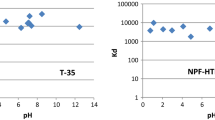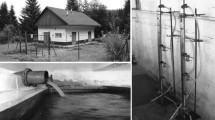Abstract
In this paper, the possibility of caesium sorption on microfibres produced by the Slovak Academy of Sciences was investigated. Sorption capacity limit of sorbent was increased by chemical modification. The binding of Cs to the surface of potassium copper ferrocyanide modified carbon microfibers was demonstrated by SEM–EDX analysis. Statistical comparison of the models showed that the Freundlich isothermal model was more suitable for describing sorption processes. The influence of desorption, pH value, competing ions and water volume were also tested. According to the results, this method seems to be suitable for large-scale caesium separation from contaminated waters.






Similar content being viewed by others
References
Alinaghizadeh H, Wålinder R, Vingård E, Tondel M Total cancer incidence in relation to 137Cs fallout in the most contaminated counties in Sweden after the Chernobyl nuclear power plant accident: a register-based study. (2044–6055 (Electronic))
Liu X, Chen G-R, Lee D-J, Kawamoto T, Tanaka H, Chen M-L, Luo Y-K (2014) Adsorption removal of cesium from drinking waters: a mini review on use of biosorbents and other adsorbents. Biores Technol 160:142–149. https://doi.org/10.1016/j.biortech.2014.01.012
Zhang H, Kim YK, Hunter TN, Brown AP, Lee JW, Harbottle D (2017) Organically modified clay with potassium copper hexacyanoferrate for enhanced Cs+ adsorption capacity and selective recovery by flotation. J Mater Chem A 5(29):15130–15143. https://doi.org/10.1039/C7TA03873A
Yang H, Sun L, Zhai J, Li H, Zhao Y, Yu H (2014) In situ controllable synthesis of magnetic Prussian blue/graphene oxide nanocomposites for removal of radioactive cesium in water. J Mater Chem A 2(2):326–332. https://doi.org/10.1039/C3TA13548A
Sangvanich T, Sukwarotwat V, Wiacek RJ, Grudzien RM, Fryxell GE, Addleman RS, Timchalk C, Yantasee W (2010) Selective capture of cesium and thallium from natural waters and simulated wastes with copper ferrocyanide functionalized mesoporous silica. J Hazard Mater 182(1):225–231. https://doi.org/10.1016/j.jhazmat.2010.06.019
Shakir K, Sohsah M, Soliman M (2007) Removal of cesium from aqueous solutions and radioactive waste simulants by coprecipitate flotation. Sep Purif Technol 54(3):373–381. https://doi.org/10.1016/j.seppur.2006.10.006
Adavan Kiliyankil V (2014) Encapsulation of adsorptive particles into CNT-reinforced alginate gels for the development of high-performance adsorbent for cesium and strontium eliminations. 博士 (環境科学), 北海道大学,
Dumanlı AG, Windle AH (2012) Carbon fibres from cellulosic precursors: a review. J Mater Sci 47(10):4236–4250. https://doi.org/10.1007/s10853-011-6081-8
Bacon R (1959) Filamentary Graphite and Method for Producing the Same. United States Patent
Bacon R, Cranch GE, Moyer JRO, Watts WH (1967) Process for manufacturing flexible carbonaceous textile material. United States Patent
Schalamon WA, Bacon R (1970) Process for producing carbon fibers having a high young's modulus of elasticity. United States Patent,
Kaushik VK, Bhardwaj A (1994) Characterization of carbon fibre surfaces using electron spectroscopy for chemical analysis. Polym Testing 13(4):355–362. https://doi.org/10.1016/0142-9418(94)90005-1
Morgan P (2005) Carbon fibers and their composites. 1st edition edn. CRC Press, Boca Raton. Doi:https://doi.org/10.1201/9781420028744
Huang X (2009) Fabrication and properties of carbon fibers. Materials (Basel) 2(4):2369–2403. https://doi.org/10.3390/ma2042369
Peters ST (1998) Handbook of composites. 2nd edition edn. Springer. Doi:https://doi.org/10.1007/978-1-4615-6389-1
Watt W (1970) Production and properties of high modulus carbon fibres. Proc R Soc Lond A 319(1536):5–15
Edie DD, Fox NK, Barnett BC, Fain CC (1986) Melt-spun non-circular carbon fibers. Carbon 24(4):477–482. https://doi.org/10.1016/0008-6223(86)90271-X
Yamashita A, Sasaki T, Tanaka S (2017) Electrochemical synthesis and immobilization of a beadwork-like Prussian Blue on carbon fiber and the removal of cesium. J Environ Chem Eng 5(3):2912–2920. https://doi.org/10.1016/j.jece.2017.05.043
Vipin AK, Fugetsu B, Sakata I, Isogai A, Endo M, Li M, Dresselhaus MS (2016) Cellulose nanofiber backboned Prussian blue nanoparticles as powerful adsorbents for the selective elimination of radioactive cesium. Sci Rep 6(1):37009. https://doi.org/10.1038/srep37009
Lab O Origin Pro 9. https://www.originlab.com/.
Silliková V, Dulanská S, Horník M, Jakubčinová J, Mátel Ľ (2020) Impregnated fly ash sorbent for cesium-137 removal from water samples. J Radioanal Nucl Chem 324(3):1225–1236. https://doi.org/10.1007/s10967-020-07132-6
Dulanská S, Zvachová S, Silliková V, Mátel Ľ, Šauša O, Maťko I (2018) Modified biosorbent wood-decay fungus Fomes fomentarius for pre-concentration of 137Cs in water samples. J Radioanal Nucl Chem 318(3):2493–2500. https://doi.org/10.1007/s10967-018-6332-0
Pilson MEQ (2012) An Introduction to the Chemistry of the Sea. 2 edn. Cambridge University Press, Cambridge. Doi: https://doi.org/10.1017/CBO9781139047203
Vincent T, Vincent C, Guibal E (2015) Immobilization of metal hexacyanoferrate ion-exchangers for the synthesis of metal ion sorbents—a mini-review. 20 (11):20582–20613
Ayrault S, Jimenez B, Garnier E, Fedoroff M, Jones DJ, Loos-Neskovic C (1998) Sorption mechanisms of cesium on CuII2FeII(CN)6and CuII3[FeIII(CN)6]2Hexacyanoferrates and their relation to the crystalline structure. J Solid State Chem 141(2):475–485. https://doi.org/10.1006/jssc.1998.7997
Han F, Zhang G-H, Gu P (2013) Adsorption kinetics and equilibrium modeling of cesium on copper ferrocyanide. J Radioanal Nucl Chem 295(1):369–377. https://doi.org/10.1007/s10967-012-1854-3
Azizian S (2004) Kinetic models of sorption: a theoretical analysis. J Colloid Interface Sci 276(1):47–52. https://doi.org/10.1016/j.jcis.2004.03.048
Piperopoulos E, Calabrese L, Mastronardo E, Milone C, Proverbio E (2020) 8-Carbon-based sponges for oil spill recovery. In: Abd-Elsalam KA (ed) Carbon nanomaterials for agri-food and environmental applications. Elsevier, pp 155–175. Doi:https://doi.org/10.1016/B978-0-12-819786-8.00008-6
Ray SS, Gusain R, Kumar N (2020) Chapter five - Adsorption equilibrium isotherms, kinetics and thermodynamics. In: Ray SS, Gusain R, Kumar N (eds) Carbon nanomaterial-based adsorbents for water purification. Elsevier, pp 101–118. Doi:https://doi.org/10.1016/B978-0-12-821959-1.00005-2
Sahoo TR, Prelot B (2020) Chapter 7 - Adsorption processes for the removal of contaminants from wastewater: the perspective role of nanomaterials and nanotechnology. In: Bonelli B, Freyria FS, Rossetti I, Sethi R (eds) Nanomaterials for the detection and removal of wastewater pollutants. Elsevier, pp 161–222. Doi:https://doi.org/10.1016/B978-0-12-818489-9.00007-4
Snipes M, Taylor DC (2014) Model selection and Akaike Information Criteria: An example from wine ratings and prices. Wine Econ Policy 3(1):3–9. https://doi.org/10.1016/j.wep.2014.03.001
Chen F-P, Jin G-P, Peng S-Y, Liu X-D, Tian J-J (2016) Recovery of cesium from residual salt lake brine in Qarham playa of Qaidam Basin with prussian blue functionalized graphene/carbon fibers composite. Colloids Surf A 509:359–366. https://doi.org/10.1016/j.colsurfa.2016.09.030
Su J-Y, Jin G-P, Chen T, Liu X-D, Chen C-N, Tian J-J (2017) The characterization and application of prussian blue at graphene coated carbon fibers in a separated adsorption and electrically switched ion exchange desorption processes of cesium. Electrochim Acta 230:399–406. https://doi.org/10.1016/j.electacta.2017.02.027
Proctor A, Toro-Vazquez JF (1996) The Freundlich isotherm in studying adsorption in oil processing. J Am Oil Chem Soc 73(12):1627–1633. https://doi.org/10.1007/BF02517963
Kumar U, Bandyopadhyay M (2006) Sorption of cadmium from aqueous solution using pretreated rice husk. Biores Technol 97(1):104–109. https://doi.org/10.1016/j.biortech.2005.02.027
Van der Bruggen B (2016) Freundlich isotherm, pp 834–835. Doi:https://doi.org/10.1007/978-3-662-44324-8_254
Mu T-H, Sun H-N (2019) Chapter 22—sweet potato leaf polyphenols: preparation, individual phenolic compound composition and antioxidant activity. In: Watson RR (ed) Polyphenols in plants (Second Edition). Academic Press, pp 365–380. Doi:https://doi.org/10.1016/B978-0-12-813768-0.00022-0
Yang S, Han C, Wang X, Nagatsu M (2014) Characteristics of cesium ion sorption from aqueous solution on bentonite- and carbon nanotube-based composites. J Hazard Mater 274:46–52. https://doi.org/10.1016/j.jhazmat.2014.04.001
Vipin AK, Hu B, Fugetsu B (2013) Prussian blue caged in alginate/calcium beads as adsorbents for removal of cesium ions from contaminated water. J Hazard Mater 258–259:93–101. https://doi.org/10.1016/j.jhazmat.2013.04.024
Takahashi A, Kitajima A, Parajuli D, Hakuta Y, Tanaka H, Ohkoshi S-i, Kawamoto T (2016) Radioactive cesium removal from ash-washing solution with high pH and high K+-concentration using potassium zinc hexacyanoferrate. Chem Eng Res Des 109:513–518. https://doi.org/10.1016/j.cherd.2016.02.027
Acknowledgements
This work was supported by the Slovak Research and Development Agency [APVV-17-015], the Scientific Grant Agency of the Slovak Republic [KEGA 015UK-4/2020]. This research was part of a dissertation theses at the department of Nuclear Chemistry of Comenius University of Bratislava in the Slovak Republic.
Author information
Authors and Affiliations
Corresponding author
Ethics declarations
Conflict of interest
The authors declare that they have no conflict of interest.
Additional information
Publisher's Note
Springer Nature remains neutral with regard to jurisdictional claims in published maps and institutional affiliations.
Rights and permissions
About this article
Cite this article
Silliková, V., Jakubčinová, J., Horník, M. et al. Determination of caesium-137 in water samples using modified carbon microfibers. J Radioanal Nucl Chem 331, 1275–1284 (2022). https://doi.org/10.1007/s10967-022-08212-5
Received:
Accepted:
Published:
Issue Date:
DOI: https://doi.org/10.1007/s10967-022-08212-5




